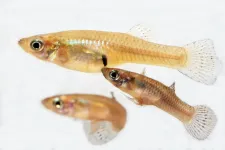AI predicts diabetes risk by measuring fat around the heart
A team led by researchers from Queen Mary University of London has developed a new artificial intelligence (AI) tool that is able to automatically measure the amount of fat around the heart from MRI scan images.
2021-07-07
(Press-News.org) A team led by researchers from Queen Mary University of London has developed a new artificial intelligence (AI) tool that is able to automatically measure the amount of fat around the heart from MRI scan images.
Using the new tool, the team was able to show that a larger amount of fat around the heart is associated with significantly greater odds of diabetes, independent of a person's age, sex, and body mass index.
The research is published in the journal Frontiers in Cardiovascular Medicine and is the result of funding from the CAP-AI programme, which is led by Barts Life Sciences, a research and innovation partnership between Queen Mary University of London and Barts Health NHS Trust.
The distribution of fat in the body can influence a person's risk of developing various diseases. The commonly used measure of body mass index (BMI) mostly reflects fat accumulation under the skin, rather than around the internal organs. In particular, there are suggestions that fat accumulation around the heart may be a predictor of heart disease, and has been linked to a range of conditions, including atrial fibrillation, diabetes, and coronary artery disease.
Lead researcher Dr Zahra Raisi-Estabragh from Queen Mary University of London said: "Unfortunately, manual measurement of the amount of fat around the heart is challenging and time-consuming. For this reason, to date, no-one has been able to investigate this thoroughly in studies of large groups of people.
"To address this problem, we've invented an AI tool that can be applied to standard heart MRI scans to obtain a measure of the fat around the heart automatically and quickly, in under three seconds. This tool can be used by future researchers to discover more about the links between the fat around the heart and disease risk, but also potentially in the future, as part of a patient's standard care in hospital."
The research team tested the AI algorithm's ability to interpret images from heart MRI scans of more than 45,000 people, including participants in the UK Biobank, a database of health information from over half a million participants from across the UK. The team found that the AI tool was accurately able to determine the amount of fat around the heart in those images, and it was also able to calculate a patient's risk of diabetes.
Dr Andrew Bard from Queen Mary University of London, who led the technical development, added: "The AI tool also includes an in-built method for calculating uncertainty of its own results, so you could say it has an impressive ability to mark its own homework."
Professor Steffen Petersen from Queen Mary University of London, who supervised the project, said: "This novel tool has high utility for future research and, if clinical utility is demonstrated, may be applied in clinical practice to improve patient care. This work highlights the value of cross-disciplinary collaborations in medical research, particularly within cardiovascular imaging."
INFORMATION:
CAP-AI is led by Capital Enterprise in partnership with Barts Health NHS Trust and Digital Catapult and The Alan Turing Institute and is funded by the European Regional Development Fund and Barts Charity.
More information
* Research paper: 'Automated quality-controlled cardiovascular magnetic resonance pericardial fat quantification using a convolutional neural network in the UK Biobank'. Andrew Bard, Zahra Raisi-Estabragh, Maddalena Ardissino, Aaron Lee, Francesca Pugliese, Damini Dey, Sandip Sarkar, Patricia B. Munroe, Stefan Neubauer, Nicholas C. Harvey, Steffen E. Petersen. Frontiers in Cardiovascular Medicine. Available here: https://www.frontiersin.org/articles/10.3389/fcvm.2021.677574
ELSE PRESS RELEASES FROM THIS DATE:
2021-07-07
Many people instinctively associate mucus with something disgusting, but in fact, it has incredibly many valuable functions for our health. It keeps track of our important intestinal flora and feeds the bacteria. It covers all internal surfaces of our body, and, as a barrier to the outside world, it helps us protect ourselves from infectious diseases.
This is because mucus acts as a filter that keeps the bacteria in or out, and the bacteria feed on the sugars in the mucus between meals. So, if we can produce the mucus that is already present in the body with the right sugars, it might be used in brand new medical treatments.
Now, researchers from the DNRF Centre ...
2021-07-07
Physicists of Ruhr-Universität Bochum (RUB) have taken spectacular pictures that allow the ignition process of plasma under water to be viewed and tracked in real time. Dr. Katharina Grosse has provided the first data sets with ultra-high temporal resolution, supporting a new hypothesis on the ignition of these plasmas: In the nanosecond range, there is not enough time to form a gas environment. Electrons generated by field effects lead to the propagation of the plasma. The nanosecond plasma ignites directly in the liquid, regardless of the polarity of the voltage. The report from the Collaborative Research Centre 1316 "Transient Atmospheric Pressure Plasmas: from Plasma to Liquids to Solids" has been published in the Journal of Applied Physics and Rubin, the ...
2021-07-07
COLUMBUS, Ohio - Female vampire bats establish an egalitarian community within a roost rather than a society based on a clear hierarchy of dominance that is often seen in animal groups, a new study suggests.
Researchers observed more than 1,000 competitions for food among a colony of 33 adult female bats and juveniles living in captivity, assigning a rank to each bat based on a calculation of wins and losses in those contests.
The team found that, unlike in many mammal societies, the higher-ranking animal didn't necessarily win every bout over food, and there was a randomness to the ranking order - no specific quality they measured gave a bat a better chance at dominance, so any adult female had an equal opportunity to rank very high or very low on a scale of ...
2021-07-07
Environmental education provision needs greater investment and innovation if future generations are to be able to respond fully to the climate emergency, experts have said.
The deepening environmental crisis will continue to worsen if there is not significant support and investment in environmental and science education, researchers have warned. Reforms would help young people to address the complex, interlinked and dynamic issues of our contemporary situation.
The experts argue Governments and other organisations must direct more funding to education innovation in response to consistent warnings from scientists about trends in the deteriorating state of ecosystems, biodiversity and climate, amongst other environmental issues.
Writing in Environmental Education ...
2021-07-07
In mosquitofish, of the genus Gambusia, male fish are smaller than females - sometimes only half the size. Biologists had previously assumed that smaller male mosquitofish had at least some reproductive advantages. Researchers from the transregional collaborative research centre NC³ at Bielefeld University have shown in a systematic review and meta-analysis that larger mosquitofish are actually more successful at reproduction: they can, for instance, better challenge their rivals; they produce more sperm; and they are preferred by female fish. The re-searchers are presenting their findings today (07.07.2021) in the Journal of Animal Ecology.
Mosquitofish are small fish with nondescript coloring of the genus Gambusia, which contains some 45 species. ...
2021-07-07
There are some large shield volcanoes in the world's oceans where the lava is usually not ejected from the crater in violent explosions, but flows slowly out of the ground from long fissures. In the recent eruption of the Sierra Negra volcano in the Galapagos Islands, which lie just under a thousand kilometres off South America in the Pacific Ocean, one of these fissures was fed through a curved pathway in June 2018. This 15 kilometre-long pathway, including the kink, was created by the interaction of three different forces in the subsurface, Timothy Davis and Eleonora Rivalta from the GFZ German ...
2021-07-07
Driving through a tunnel is a challenging and risky task. Drivers need to lower their speed and adapt to poor light, while the enclosed space may make them anxious. Preventing accidents is a public health challenge that uses insights from engineering, psychology, physiology, and neuroscience. Here, in a virtual reality (VR) study in Frontiers in Psychology, scientists from China, Canada, and the USA show that playback of slow music inside tunnels can reduce tension and fatigue in drivers, making them less prone to speeding and overtaking. These results imply that well-chosen background music can help improve road safety.
"When drivers go through a tunnel, they need to process a large amount ...
2021-07-07
How do predators know to avoid brightly-coloured toxic prey? A collaboration of researchers has put social information theory to the test in a reliable real-world system to find the answer - by copying what others do, or do not, eat.
An international team of researchers from Finland, New Zealand, Colombia and the U.K. have provided the first evidence that wild birds can learn to avoid distasteful prey by observing what others eat.
"We've known for a long time that predators, like birds, associate brightly coloured warning signals with the danger of eating certain prey types. However, ...
2021-07-07
Imagine a dust particle in a storm cloud, and you can get an idea of a neutron's insignificance compared to the magnitude of the molecule it inhabits.
But just as a dust mote might affect a cloud's track, a neutron can influence the energy of its molecule despite being less than one-millionth its size. And now physicists at MIT and elsewhere have successfully measured a neutron's tiny effect in a radioactive molecule.
The team has developed a new technique to produce and study short-lived radioactive molecules with neutron numbers they can precisely control. They hand-picked several isotopes of the same molecule, each with one more neutron than the next. When they measured each molecule's energy, they were able to detect small, nearly imperceptible changes of the nuclear ...
2021-07-07
BOSTON - The numbers of cancer screening tests rebounded sharply in the last quarter of 2020, following a dramatic decline in the first months of the COVID-19 pandemic, at one large hospital system in the Northeastern United States. These findings were released in a study published in Cancer Cell. The research also found an increase in racial and socioeconomic disparities among users of some screening tests during the pandemic.
Study co-senior author Toni K. Choueiri, MD, director of the Lank Center for Genitourinary Oncology at Dana-Farber Cancer Institute, said following a dramatic decline during the first pandemic peak, there was a "substantial increase in screening procedures during the more recent periods ...
LAST 30 PRESS RELEASES:
[Press-News.org] AI predicts diabetes risk by measuring fat around the heart
A team led by researchers from Queen Mary University of London has developed a new artificial intelligence (AI) tool that is able to automatically measure the amount of fat around the heart from MRI scan images.

